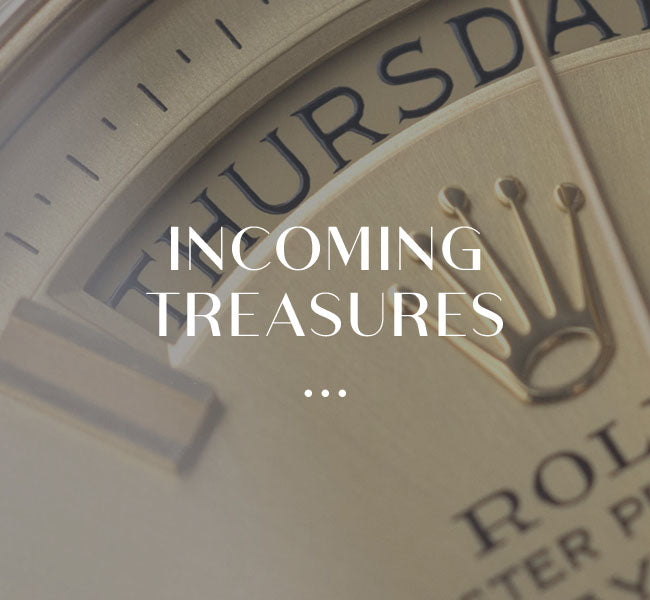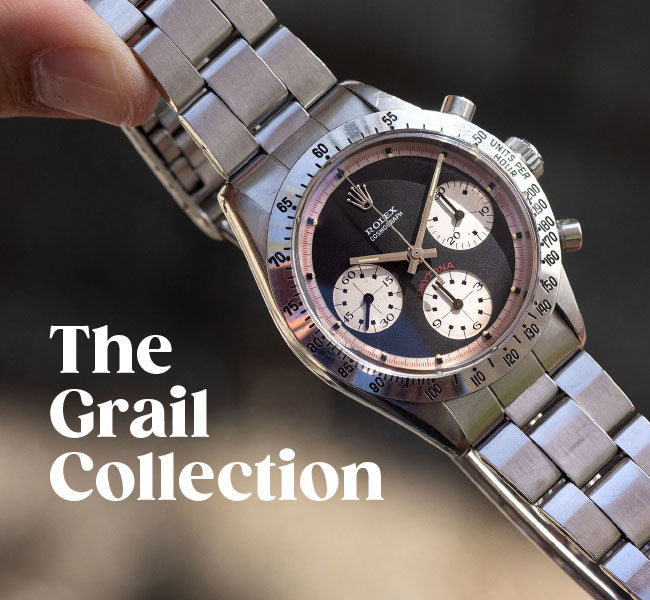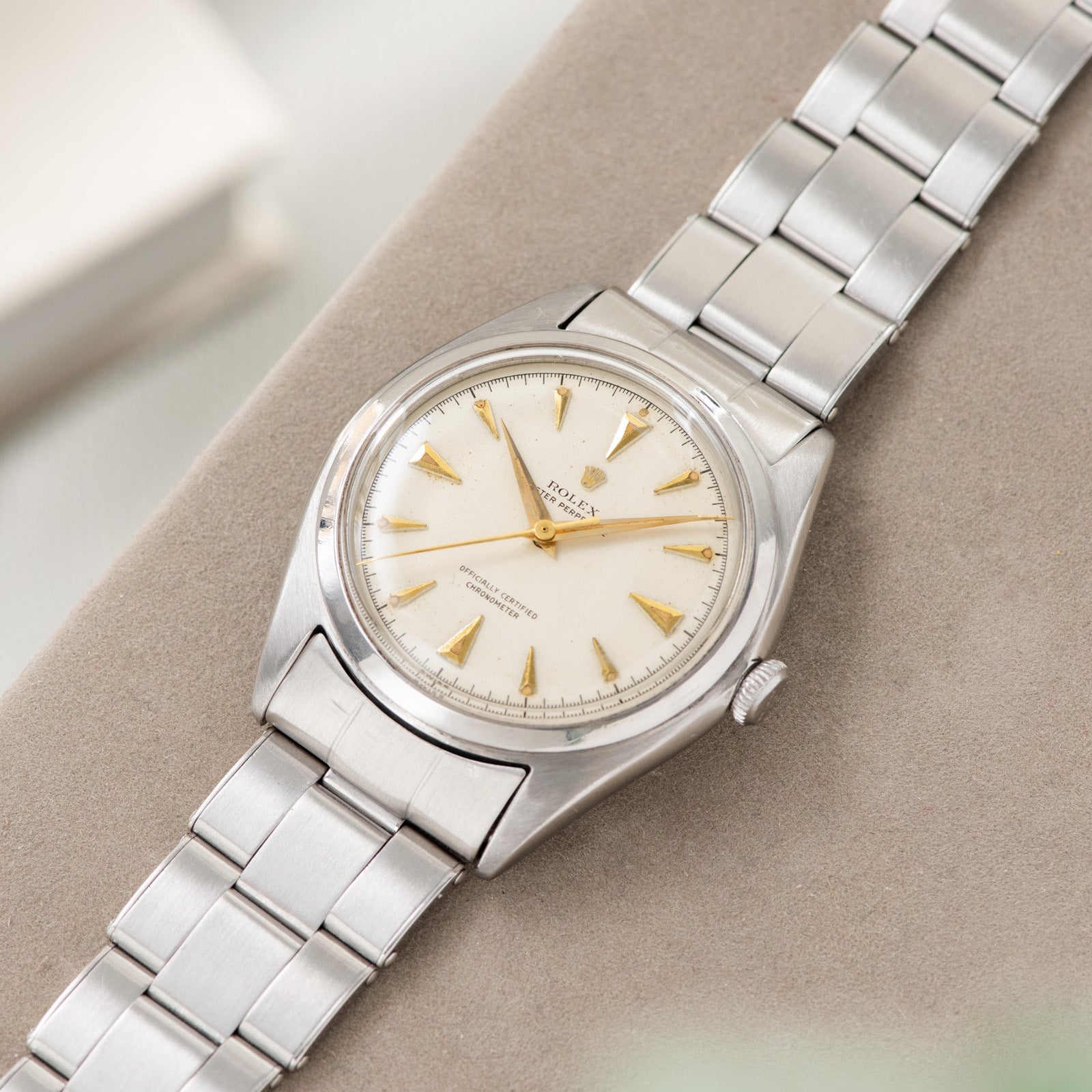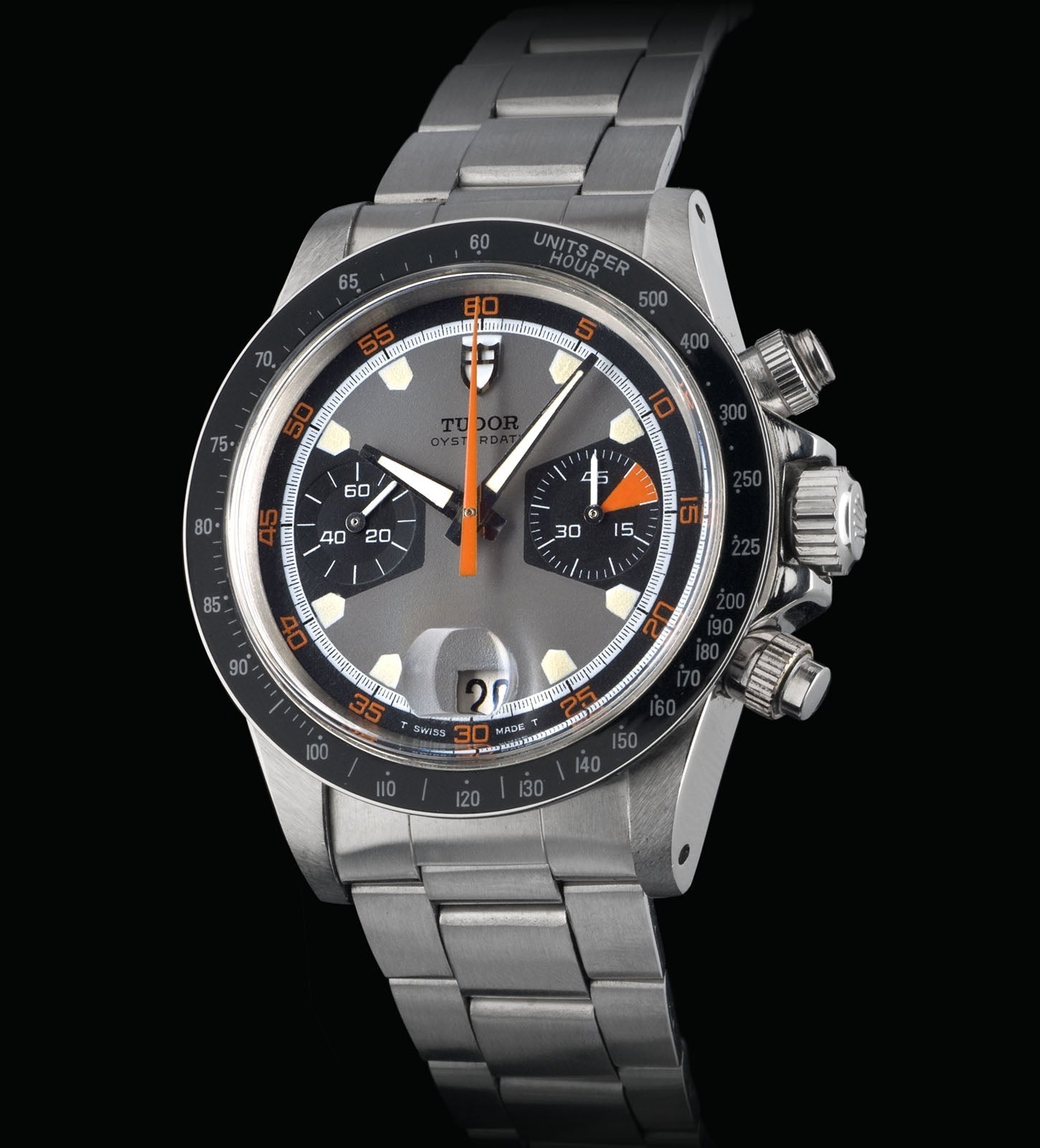
50 Years of Tudor Chronographs: The Vintage Era
2020 is the second year in a row that Tudor has marked a Golden Anniversary. Last year, in 2019 the brand celebrated 50 years since the introduction of the iconic and Tudor trademark snowflake hands. You might remember we wrote about it here. 2020 is the year in which Tudor has clocked up 50 years of their chronograph. Always cool looking and often innovative, vintage Tudor chronographs have really picked up speed with collectors over the past few years. Whereby the vintage Daytona is quite diminutive in its 36mm case, the Tudors of the era were larger watches that packed more of a punch. Today we are taking a look at the first three decades of the Tudor chronographs and celebrating Wilsdorf’s most colourful timers…


Home is Where the ‘Stop/Start’ is
The story begins with what has arguably become the most iconic of all Tudor watches, the original 7000 series Osyterdate chronograph, more famously known by collectors as the Home Plate. This series had two references – the 7031 and 7032 that were launched simultaneously in 1970. In line with Tudor’s current marketing slogans, these watches were daring and unlike any sports watch that had come out of the House of Wilsdorf. The watches were housed in robust 40mm cases that utilised the Oyster chronograph pushers from its cousin the Daytona but also featured crown guards and the 7mm twin-lock screw-down crown that was in use in the Submariner and Seadweller watches. The 7000 series chronos also featured an additional complication of a date window at six o’clock on the dial and were driven by manually wound modified Valjoux movements.


Iconic Design
The dials on these watches are cool and unlike anything else that came before or after the watch. It was both bright and unusual in its use of detail and colour. The most notable feature of the 7000 series dials is the shape of the hour markers, which are like the home plate on a baseball field. This led to collectors giving the watch its well-known nickname the Home Plate. The base colour of the dial is grey, with a black outer track that had five-second arabic numerals in bright orange. The two sub dials are black with the right side dial (the minute counters) featuring an orange triangle in the 5-10 minute portion. The orange also pops on the sweeping stopwatch hand. It’s a stunning combination of colours and to many people is the Paul Ranston of Tudor collecting.
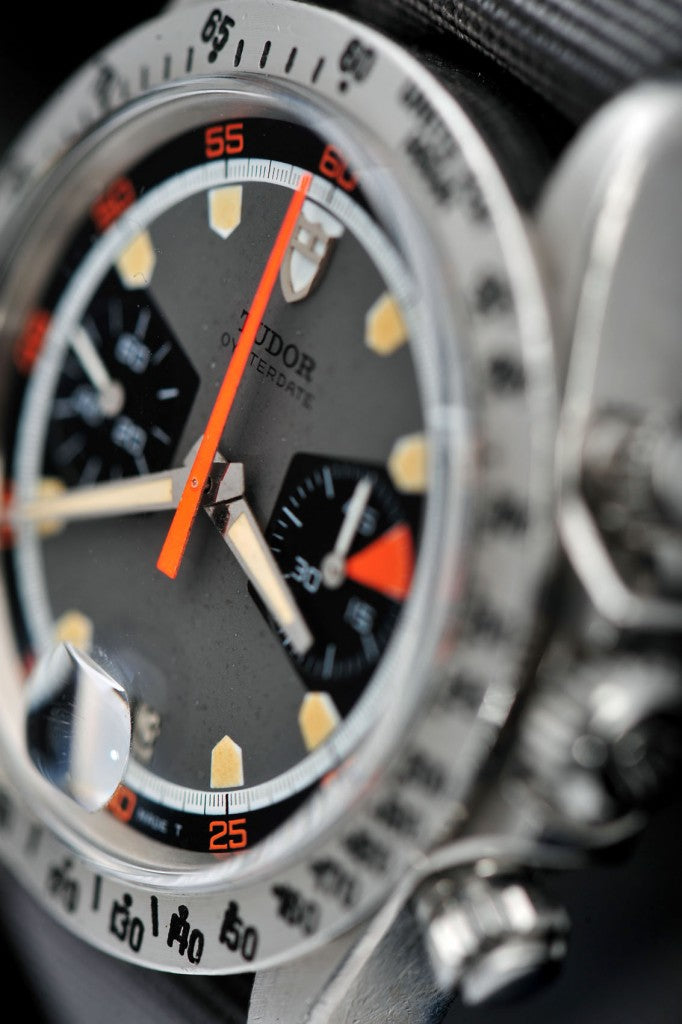

As with all things Rolex and Tudor there is a very rare variant of Home Plate that features a black version of the dial. If the regular Home Plate is a Ranston, then the black Home Plate is the Oyster Sotto Ranston! There are a couple of theories about the black dials, but it is believed that these black dials were sent to Tudor dealers to replace the spots that appeared on some grey dials. I believe that some authorized dealers originally sold some of these watches with black dials in the early 1970s as new, therefore some were sold new to customers and were never actually originally sold with grey dials. Whatever the story, the dark element of these dials when combined with a black bezel 7031 is such a cool and strong look.
All About The Bezel
Tudor often differentiated their references by bezel type. So technically, the two watches in the 7000 series were essentially identical with the only difference being the bezel. The 7031 featured a black plastic tachymeter bezel and the 7032 featured an all stainless steel tachymeter. Both watches are now rare and sought after but the 7031 is maybe harder to find in great condition as the plastic bezels were quite easily damaged and are now virtually impossible to find as a replacement part.


Tudor launched their Heritage watches in 2010 with the Heritage Chrono that was essentially a modern version of the 7000 series of Homeplate chronos. Tudor acknowledged the black dial in offering both a grey and a black option in celebration of the originals. In the late 60sor early 70s there was also a prototype made, that never actually went into production, with a rotating 12-hour bezel. This watch was identical to the 7031 and 7032, but had a bi-directional 12-hour bezel made from a black aluminium insert. Whilst this reference never made it to production, it was this watch that was the inspiration for the Heritage Chrono. Read Bernhard’s original epic post here.


The Gaming Continues in Monte Carlo
The cool use of colour that was the signature of the Home Plates was continued with Tudor’s second series of chronos. Launched in 1971, the vivid tones of orange and grey seen on the Homeplates was carried through to the 7100 series and joined by a new blue and orange colour scheme. Again, the 7100 series were executed in the large 40mm steel cases and retained the screw-down Oyster pushers and the 7mm screw-down crown. In the second series of Chronographs the home plate markers were replaced with more conventional rectangle shaped lume plots. The use of bright orange remained with eye-catching elements on both chronograph registers as well as on the outer seconds markers. The watches have become known by collectors as Monte Carlos, as the dials resembled the roulette tables of the casinos of Monaco.


Bezel Trio
As with the first series watches, the different Monte Carlo references were fitted with bezels. Tudor now offered a third bezel variation in the second series having experimented with the 12-hour bi-directional rotating bezel on the prototype 7033. The Home Plates had been equipped with the Valjoux calibre 7734, but the second series chronos housed the Valjoux calibre 234. This was a high-frequency movement with improved accuracy and also had upgrades to the column wheel and clutch.
The Monte Carlo chronos were available in three references:
7149 – Plastic tachymeter bezel
7159 – Steel tachymeter bezel
7169 – Rotating 12-hour bezel

The Monte Carlos continued to use the triangular orange stopwatch second hand and had two sub dials and date aperture at six o’clock. The new blue colour sche,e meant that Tudor had to also make a blue acrylic tachymeter bezel on the 7149s and a blue 12-hour bezel insert on the 7169 to match the dials.
In a similar pattern to the early 1970s, in 2013 Tudor released a second Heritage Chrono, but this time in Blue. The second version strongly influenced by the 7169 Monte Carlo. The Heritage edition was housed in the 42mm case with sapphire crystal and had a blue 12-hour rotating bezel. Again, it was a massive hit with both modern and vintage watch fans and gave the vintage chronos a firm push in the maket.

The Big Block
In 1976, Tudor was the first Wilsdorf brand to launch an automatic chronograph, a full 12 years before Rolex introduced their first automatic Daytona. Interestingly, it was this automatic movement that led to the watch’s nickname. The rotor and autowind mechanism of the movement meant that Tudor needed to design a new watchcase that was deeper, hence the collector term ‘Big Block’. The second most important change that occurred with the Big Block was the introduction of a third chronograph register on the dial – an hour indicator. The previous two series, the Home Plates and Mote Carlos, were in essence 45-minute stopwatches, but the new watches could measure up to 12 hours!

The Early Big Blocks
The first Big Block watches were the 9000 series. As was tradition, the references were differentiated by the bezel type. The 9000 series watches comprised references:
9420 – Plastic tachymeter bezel
9421 – Rotating 12-hour bezel
9430 – Steel tachymeter scale bezel

Unable to leave behind the cool and eye-catching dial designs, Tudor continued to produce exotic dials in the Big Blocks. Collectors also refer to these as Exotic Big Blocks. There were two variations of Exotic Big Block dials, a version with painted hour markers that were very reminiscent of the 7100 series watches and a version with applied metal hour markers. The dials with painted hour markers were available in two colourways – grey/black/orange and grey/blue/orange. Both dial colours were available in all three references. The black version was always teamed with a black tachymeter or 12-hour scale bezel and the blue dials with blue tachymeter bezels. These watches are now very rare and are sought after by collectors, especially the blue 9420. The dials with applied metal hour markers were only produced in black, which featured white sub dials and orange numbers on the outer minute track. This dial was only featured in two references – the 9420 watch (with a black plastic tachymeter bezel) and the 9430 (with stainless steel tachymeter bezel).

Second Big Coming
In the late 1980’s Tudor replaced the 94300 series watches with the 79100 series, which ran into the late 1980s and early 90s. These watches had the same deep Big Block case, but were only available with two colour, non-exotic dial configuration.

As with the 9400 series, there were three references which were all differentiated by their bezel type:
79160 – Black plastic tachymeter bezel
79170 – 12 hour rotating bezel
79180 – Steel tachymeter bezel



We have always loved the Big Block watches at Bulang and Sons. They are an important chapter in the Tudor story as a demonstration of both Tudor’s freedom to experiment with more exotic and playful design and also the fact that they were the first automatic chronograph out of the Rolex camp. If you’re looking for a 40mm vintage chrono that is automatic and stylish, maybe the Big Block is still the best value proposition in the market.


